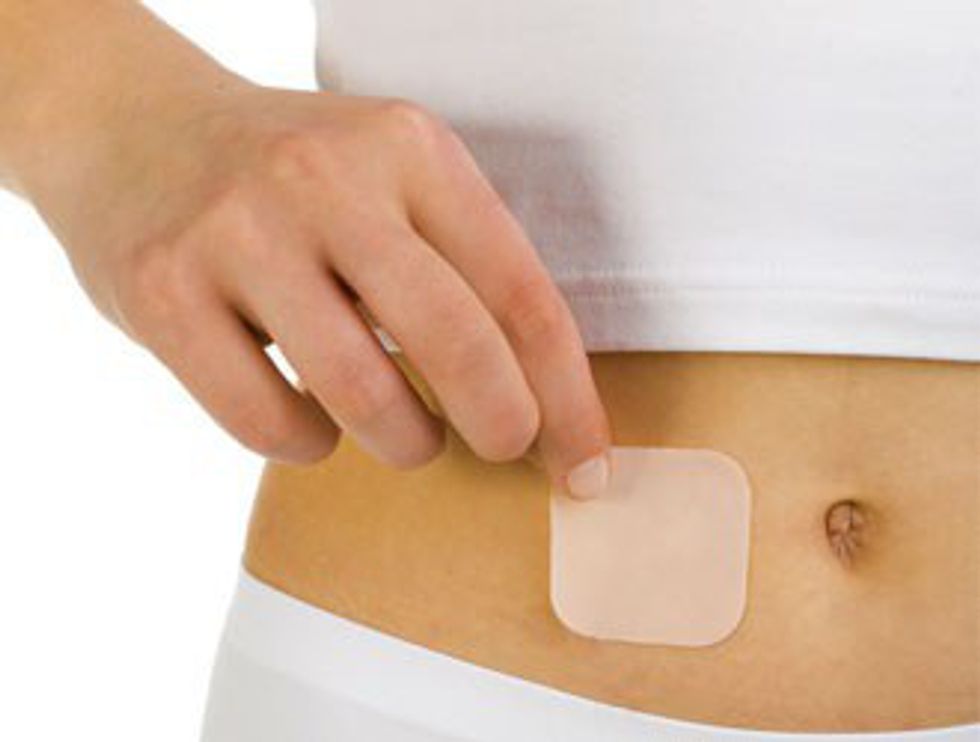So, you know about condoms, you know about the pill, and maybe you even know a thing or two about the IUD, but here’s the thing: There are a ton of other contraceptive methods on the market for you to choose from! In fact, there are so many options it can be overwhelming trying to decide which one is right for you. Here’s a simple fact sheet about the methods available to you so you can make a well-informed decision.
1. Abstinence
Sure, this one seems silly—“I thought you were going to teach us how to have safe sex, I already know how to not have sex!”—but abstinenceisthe only foolproof way to make sure you remain totally STI free and avoid any unintended pregnancy. It’s completely free, completely safe, and 100 percent effective. Abstinence might be the right choice for you if you want to wait until you find the right partner, have religious or moral reasons for why you’d want to wait, want to focus on school or a career, are getting over a traumatic event in your life, just got out of a serious relationship, or are following medical advice. Any reason that you might have for wanting to abstain from sex is entirely valid. If and when you wish to have sex, however, make sure you practice safe sex and choose a contraceptive method!
2. Implant
The implant birth control is a little rod about the size of a matchstick that gets inserted in your upper arm. Your doctor numbs the area and inserts the rod that is then out of sight and out of mind! It releases the hormone progestin which prevents ovulation and thickens the cervical mucous to prevent sperm from reaching the egg. Less than 1 out of 100 women per year will become pregnant while using this method—so it’s pretty darn effective. What’s great about the implant is you don’t have to worry about it once it’s implanted; it offers continuous, long-lasting birth control for up to three years; you can use it while breastfeeding; and the ability to become pregnant returns quickly after use. Side effects are irregular bleeding within the first 6-12 months of use, change in sex drive, discoloring or scarring of the skin over the implant, headaches, an infection or pain in the arm, nausea, pain at the insertion site, sore breasts, and weight gain. Most of these side effects are rare!
3. The Pill
Probably one of the better-known forms of birth control, the pill is an oral contraceptive that a woman takes once, daily. Each week has different doses of hormones, until the fourth placebo week when the pills are just made of sugar. The pill releases the hormones progestin and estrogen, which prevent pregnancy by thickening the cervical mucous and keeping the eggs from being released from the ovaries. There are several different brands of the pill, each with its own dosage of progestin and estrogen—your doctor will decide which formula is best for your body. When taken as directed, the pill is about 96 percent effective in preventing pregnancy. In addition to pregnancy prevention, the pill helps to protect against health problems such as: Acne, bone thinning, breast growths that are not cancer, ectopic pregnancy, endometrial and ovarian cancers, serious infection in the ovaries, tubes, and uterus, iron deficiency anemia, cysts in the breasts and ovaries, and premenstrual symptoms, including headaches and depression, bad cramps, and heavy and/or irregular periods. In some women, the pill can cause irregular bleeding and nausea. The pill does not prevent against STIs, so make sure you use a condom as well. Using a condom in addition to the pill makes them over 99 percent effective! Oral contraceptives are free with insurance but otherwise can cost only up to $50. 4. Patch
Similar to a Band-Aid, the patch is a thin, adhesive square that sticks to the skin. It releases hormones that prevent pregnancy and is changed every week for three weeks followed by a patch-free fourth week. The patch is super effective as long as you follow the directions for use perfectly! When not used as directed, the patch loses some of its effectiveness, so pay close attention to the instructions. The patch works like the pill, so it has the same benefits and disadvantages as any other oral contraceptive (listed above). The most common side effects during the first few months of using this method are irregular bleeding, breast tenderness, and nausea or vomiting. The patch may be purchased with a prescription at a drugstore or clinic; a one-month supply costs about $0–$80.
5. Shot
The birth control shot, known as Depo-Provera, is an injection given to you by your doctor every three months to prevent pregnancy. Similar to the pill, the shot is made of the hormone progestin, which keeps the egg away from the sperm. The shot is one of the most effective birth control methods available to you—about 96 percent effective!—so long as it is taken as regularly as possible every 12 weeks. Some women like the shot because it provides long-term birth control, it’s safe and convenient, you don’t have to remember to take a pill or change a patch, and it’s more discreet (you don’t have to pick up anything from a pharmacy, no packaging, etc.). Side effects of the shot are irregular bleeding. Some women, after using the shot for a while, don’t have their period at all, while others report longer, heavier periods. It just depends on how your body reacts! The shot can cost anywhere from $0-150.
6. Sponge
The sponge is kind of a throwback to the old school forms of birth control, but if you’re a fan of the OG vintage kind of stuff, this might be for you! Straight out of the package, the sponge is a little circular sponge that is about two inches in diameter. It is inserted into the vagina before intercourse and has a nylon loop attached to it for easy removal. The sponge uses built-in spermicide to kill off any sperm that enters the vagina while also making like Michael Jordan and blocking any sperm trying to get into the uterus. The sponge is most effective for women who have never given birth and can be anywhere from 89-91 percent effective. Women like the sponge because it’s small and convenient and can be inserted a couple hours prior to having sex so you don’t have to think about it in the moment! It has no hormones, which some people may prefer, and cannot be felt by you or your partner. The sponge may not be right for you if: You are allergic to sulfa drugs or the things that make up the sponge, are not comfortable touching your vagina or vulva, have certain physical problems with your vagina, have difficulty inserting the sponge, have had a recent abortion, childbirth, or miscarriage, have a history of toxic shock syndrome, or currently have a reproductive tract infection. You can buy the sponge for $15 at your local drug store.
7. NuvaRing
The NuvaRing, also called the "vaginal ring," is a small, flexible ring that is inserted into the vagina once a month to prevent pregnancy. It is left in place for three weeks and taken out for the remaining week each month. The NuvaRing is another hormonal type of birth control—the ring releases the same hormones as the pill—and prevents pregnancy by thickening the cervical mucous and making the egg release more slowly. When used correctly, the ring can be 96 percent effective. The ring carries the same benefits as the pill, such as clearing acne and making periods lighter. You should not use the ring if you: Are pregnant, get migraines, have certain inherited blood-clotting disorders, have been or are being treated for blood clots or vein inflammation, have had breast or liver cancer, have heart problems, lupus, serious liver disease, uncontrolled high blood pressure, very bad diabetes -- or have had diabetes for longer than 20 years -- have weak pelvic floor muscles, smoke and are over 35 years of age, or need to stay in bed for a prolonged period of time. The NuvaRing can cost anywhere from $0-$250.
8. Diaphragm
The diaphragm is another, older birth control method—it is a small cup made of silicon that is inserted into the vagina before sex. Like the sponge, it works by covering the opening of the cervix and preventing sperm from entering the uterus. When used correctly, the diaphragm can be anywhere from 81-96 percent effective. To increase effectiveness, it is recommended that you coat the top of the diaphragm with spermicide. Because it is so similar to the sponge, the diaphragm carries the same risks (listed above). Women like the diaphragm because it’s small and safe, can be carried in your purse, can be inserted a few hours before sex (so there’s no interruption in the heat of the moment!), cannot be felt by you or your partner, is immediately effective and reversible, and doesn’t have an effect on your body’s natural hormones. Some disadvantages to the diaphragm are that it may be difficult for some women to insert, it may be pushed out of place by some penis sizes, heavy thrusting, and certain sexual positions, it must be in place every time a woman has vaginal intercourse, and for some women it may need to be refitted. Diaphragms can be purchased at your local pharmacy with prescription and costs between $0 and $75.
9. Condom (male and female)
Condoms are thin layers of latex worn on penis during sex to collect pre-cum and sperm to prevent them from getting into the uterus. Condoms provide a barrier to prevent the spread of STIs—yay for condoms! Condoms can be anywhere from 89-96 percent effective at preventing unplanned pregnancies. Also, if condoms weren’t already amazing enough, here are more reasons why you should love them: They let men step up and help prevent pregnancy and sexually transmitted infections, they are inexpensive and easy to get (you can get them at a drug store, grocery store, a school’s health clinic, probably even from your best friend’s wallet), they are lightweight and disposable, they do not require a prescription, they can help relieve premature ejaculation, and they may help a man stay erect longer (!!!). You can even get creative with your partner and incorporate putting on the condom as part of sex play—who says sexual health isn’t sexy? There are virtually no disadvantages to condoms unless you’re allergic to latex, in which case there are different material options for you!
If birth control methods were the Kardashians, the female condom would be Rob: Never talked about and often forgotten. But female condoms are just as great as their male counterparts! The female condom is inserted into the vagina before sex and removed after sex. They have the same effectiveness as male condoms at preventing pregnancy and STIs. And hey, nothing says “I’m a strong independent woman” quite like having a lady condom in your arsenal! Remember: You cannot use a female condom and a male condom at the same time nor can you wear two male condoms or two female condoms at once. Despite what you may have heard, “double bagging” does not work and will actually decrease the effectiveness of the condom.
10. IUD
IUD stands for "intrauterine device"—a small, T-shaped device that prevents pregnancy. There are two different types: A hormonal IUD and a copper IUD. The copper IUD is effective for up to 12 years, while the hormonal IUD is effective for five. Both IUDs prevent sperm from joining with the egg—the hormonal type may also thicken the cervical mucous to further prevent pregnancy. Your doctor inserts it during a quick procedure in the exam room. Insertion can be slightly painful, feeling sort of like cramps, but the pain will alleviate in a few days. The IUD is the most effective birth control on the market, boasting about a 99 percent rate of effectiveness. IUDs are the least expensive and longest-lasting birth control option. They give the user freedom to be spontaneous because you do not have to think about inserting anything or taking a pill before sex. The hormonal IUD can also make periods 90 percent lighter and, when removed, the ability to become pregnant returns quickly. The disadvantages are that the copper IUD makes periods heavier and longer and there is risk of infection, but it is very low. The IUD can cause irregular bleeding for the first few months following insertion. The IUD can cost anywhere from $0 to $1000.
11. Morning after pill
So, you just had sex and realized the condom broke, or maybe you forgot to take your pill for a couple of days, or maybe his pull out game wasn’t as strong as he claimed it would be; whatever the situation, the morning after pill has your back. Pregnancy doesn’t happen right after sex—it can take up to six days for the sperm to reach the egg. All that the morning after pill does is keep the ovaries from producing an egg for longer than usual. You can take the pill up to five days after unprotected sex, but the sooner you take the pill the better! There are no serious complications associated with the morning after pill, but it can cause your period to come at a different time than usual, so don’t worry if that happens to you. The pill can also cause dizziness, nausea, and vomiting. Absolutely anyone can get emergency contraception over the counter at your local drug store pharmacy and it can cost anywhere from $30 to $65. Emergency contraception is for emergencies only (duh), so it shouldn’t be your first, last, and only contraception choice for all sexual encounters.
12. Pull out method
You’ve heard about it in songs and from jokes in movies, but the reality of the pull out method is more complicated than it seems. Pulling out is when the male will pull his penis out of the vagina before ejaculating—if no sperm enters the vagina, then pregnancy can’t happen. This method is simple and free, and when there are no other methods available, this is better than nothing at all! In a perfect scenario pulling out can be 96 percent effective, but more often than not it ends up closer to 75 percent-- a pretty big drop in overall effectiveness. And I know what you’re thinking, “But Bridget, how is that possible?” I’ll tell you: In the heat of the moment, a guy might not pull out in time. And whether that’s because he’s too caught up in what’s happening he can’t stop, or he just isn’t in tune with his body to know when the right moment is, it makes the pull out method more of a Russian Roulette-method. Another issue is that precum can have some sperm in it, especially if you’ve had sex multiple times in a row. All things considered, pulling out is best for partners who know their bodies and trust each other. It also works best when used in conjunction with another form of birth control such as a condom or the pill.
Overall, Planned Parenthood can provide most of these contraceptive methods to you for free or for cheap. If the one you choose simply isn’t working out, you can always try another. All percentages and statistics on this article come from the Planned Parenthood website, so if you have anymore questions, check them out!Remember that condoms are the only barriers to prevent transmission of STIs, so always wear one when you have sex with your partner even if you're already using a different form of birth control. Communicate with your partner, trust your body, and go forth and not multiply!



























